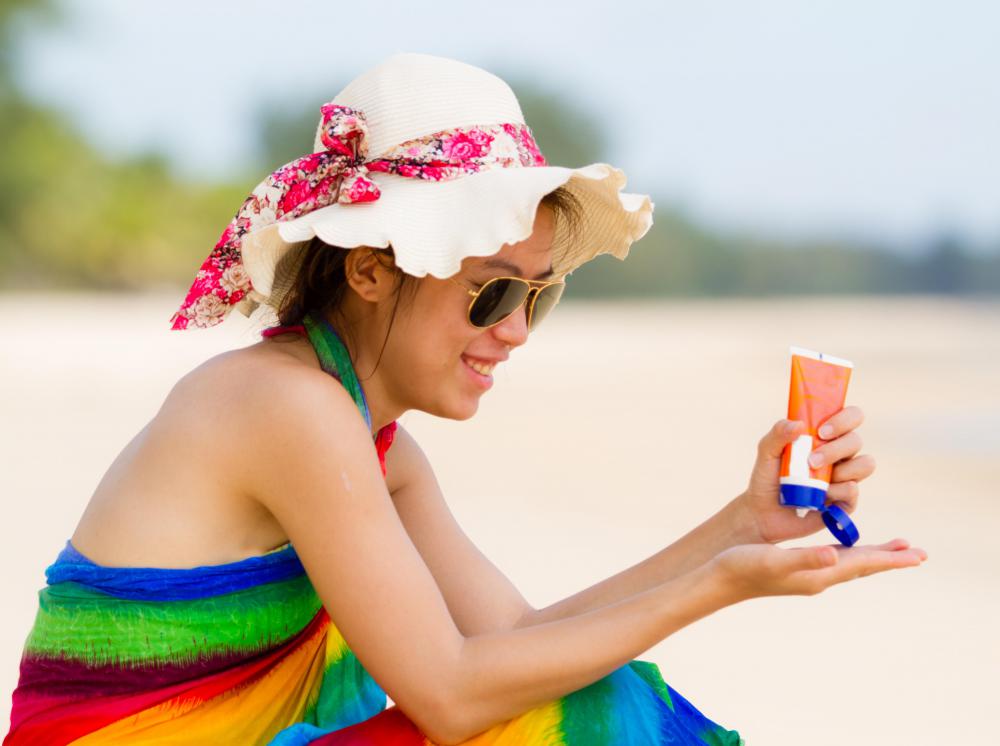At WiseGEEK, we're committed to delivering accurate, trustworthy information. Our expert-authored content is rigorously fact-checked and sourced from credible authorities. Discover how we uphold the highest standards in providing you with reliable knowledge.
How do Sunblocking Products Work?
In order to understand how sunscreening and sunblocking products work, it might be helpful to examine what happens to your exposed skin without them. The sun generates three types of radiation- infrared, visible light and ultraviolet. Of the three, only ultraviolet radiation causes the skin to tan or burn. Ultraviolet radiation is generally broken down into three forms: UV-A, UV-B, or UV-C. Only UV-A and UV-B energy reaches the skin, and only UV-B is associated with the severest forms of skin damage such as wrinkles, sunburn or melanomas.
The body has its own sunblocking mechanism called melanin. Melanin is designed to absorb both UV-A and UV-B radiation, eventually creating a protective layer of darker skin cells most tanners seek. But the sunblocking ability of melanin is limited by genetic and racial factors, which allows many lighter-skinned people to receive too much UV-B exposure and skin damage. Commercial sunblocking or sunscreen products supplement the body's own supply of melanin through either a chemical or physical bond with the skin.

The first sunblock products provided a physical barrier between the sun's UV rays and the wearer's exposed skin. Ingredients such as zinc oxide were blended into a cream base and worked by deflecting the sun's rays away from the nose and face. These sunblocking products worked well for specific areas, but were impractical for a whole body application. Today, many people who must work outdoors for hours, such as lifeguards or gardeners, still use zinc oxide creams as sunblocking aids.

Modern sunblocking products such as sunscreen lotions rely on a chemical mechanism. Different sunblocking products protect against different forms of UV radiation, so it is important to select one with UV-B or 'broad spectrum' protection for maximum benefit. Many sunscreens contain an ingredient which absorbs UV rays much like the skin's natural melanin. One of the most popular ingredients is PABA, short for para-aminobenzoic acid. PABA absorbs UV-B rays, but can also cause some allergic reactions. Broad spectrum sunblocking products contain other chemicals which absorb both UV-A and UV-B radiation.
When applying any sunblocking products, it is important to allow some time for complete absorption. Many experts recommend waiting at least 30 minutes before exposure to sun or water. Another important consideration is the SPF (sun protection factor) rating of a particular product. This information should be contained on the product's packaging. An SPF of 15 is generally considered a minimum for those who do not tan or are vulnerable to sunburn. A higher SPF number is not a guarantee against sun damage, however, and almost all sunblocking products need to be reapplied after a few hours have elapsed.
AS FEATURED ON:
AS FEATURED ON:












Discussion Comments
Latte31 - I agree with you. It is probably one of the best inventions especially for children because many of them hate wearing sun block and this sunblock clothing is so comfortable that you really can’t lose.
I also usually buy a sunblock SPF30 stick for the face. I think that it is easier to apply than the regular bottle because you have more control. It is also impossible to get it in the eye area and children can even apply their own sunblock because it just glides on and is transparent.
I just wanted to say that I love the sunblock swimwear that has an SPF of 50. I like the long sleeve tops especially since the material is lightweight. I also don’t feel hot and get sun protection the whole time that I am outside. I always buy these for my kids too and they love them.
You can really wear them anytime you are outdoors and it doesn’t only have to be when you are at the beach. I have a friend that is a cyclist and he wears this clothing every time he workouts out. Anyone that spends any length of time outside should consider investing in at least a long sleeve top with sun protection.
They range in price but they are cheaper at the big box retailers than if you buy them at the specialty stores. In a specialty store the tops usually cost about $40 or more but in the big box retailer a similar top will cost you about $25.
Post your comments